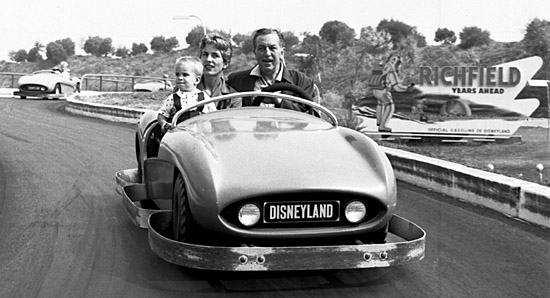It was with an overwhelming sense of shock that I learned on Tuesday that the world had lost Diane Disney Miller, first daughter of Walt Disney and the founder of the Walt Disney Family Museum, to a lingering injury brought on by a fall in September. It continues to seem unthinkable that Diane could be gone; even at the age of 79 she remained fit as a fiddle, sharp as a tack, and as spry as a woman twenty years her junior. While I can’t imagine the loss felt by her family and friends, to the rest of us – mere fans, at most – the loss still weights heavily.
Diane was not only a living link to her father – a resource that grows ever more scarce by the year – but also an active champion of his legacy and an estimable individual in her own right. She seemed very much her father’s daughter; extremely sweet and kind, but doggedly determined and with the potential to be greatly stubborn when she knew she was right. And woe betide you if you were one of those individuals who she felt disparaged her father unfairly – she would never forget!
Diane entered this world with a great deal of fanfare on December 18, 1933. Walt and Lillian Disney had suffered through several unsuccessful pregnancies, and so Walt was perhaps well more nervous than the average expectant father. Lillian had gone into labor while Walt was attending a luncheon in his honor; in front of 75 guests, he was being awarded a medal for his “distinguished service to childhood.” Notified of the impending arrival in the midst of the ceremony, Walt grabbed his coat and hat, mumbled around ten words of thanks into the microphone, and left a confused audience in his wake as he sped away to Good Samaritan hospital. The result of that day was eight pounds and two ounces of Diane Marie Disney.
After a later unsuccessful pregnancy, the Disneys decided to adopt a sister for Diane; Sharon Mae Disney was born in 1936 (she passed away in 1993). The sisters would grow up sheltered from fame and fortune, and the Hollywood hubbub. At the age of 20 Diane married USC football player, and eventual president and CEO of Walt Disney Productions, Ron Miller. They settled down and raised a large family, again removed from the spotlight.
Always averse to publicity and recognition, in the later decades of her life Diane took a very public role in protecting the legacy of her family. Perhaps doing so only because someone had to, Diane nonetheless was the perfect individual to represent her family on the world stage. It’s somehow ironic that someone who genuinely sought to avoid a public role in anything was, in fact, an excellent speaker, presenter, host, and raconteur. Diane might not have wanted to be the public face of the Disney family, but she was fantastic at it.
Assiduously private, often to the chagrin of those who sincerely sought to recognize her efforts, she seemed content tending to the family’s Silverado Vineyards in Napa Valley. Diane started to take a more visible role in the 1990s, especially following the 1997 death of her mother; she first took up the banner of completing Los Angeles’s Walt Disney Concert Hall, which finally opened in 2004.
With the approach of her father’s centennial in 2001, she began to voice the concern that her father was becoming a mere corporate branding device; a marketing ploy, instead of an actual living individual. She worried about surveys which showed that a certain percentage of the public didn’t even know Walt Disney was a real man, instead thinking him a fictional character and corporate figurehead. And she was perhaps even more concerned by a generation of biographers who sought to make their hay with poorly-researched defamations and a wave of pop-culture misconceptions fed by lazy potshots against the seemingly saccharine Disney brand.
The result of years of effort and a great deal of investment was the Walt Disney Family Foundation and its Walt Disney Family Museum, located in San Francisco. The museum is a triumph, presenting a fairly unvarnished look at the life of Walt Disney and featuring a never-ending stream of educational events, art exhibitions, and other programs.
Like many in the Disney community, I have my own brief story about Diane; I share it here only because I think it says a great deal about her. Several years ago now I wrote a long series of stories to celebrate the 100th birthday of Disney Legend Herb Ryman. One of those pieces detailed the friendship of Ryman, Walt, and professional clown Emmett Kelly. Now at the time I wrote that piece, I was stuck in a job I absolutely hated like fiery poison, writing about Disney history after work just to stay sane. One day at work, just as I was about to leave my desk for that glorious hour of tranquility known as “lunchtime”, I received an email from an address I didn’t recognize. The subject was “From Diane Disney Miller”.
My first thought was that some reader of the site was sending me some news article or something involving Diane. Reading the email, my brain slowly but surely slipped into gear and finally processed that, no, it was actually from Diane herself. The great Disney historian Jeff Kurtti had kindly shared the article with her and she had liked it, and she was writing to thank me. Needless to say I hardly touched the floor throughout lunchtime or the rest of the week.
We exchanged a few emails and she invited me to come visit the Museum in San Francisco; last year I was finally able to do just that for the opening of their excellent Snow White and the Seven Dwarfs art exhibit. It took me a while to gin up my courage to go talk to Diane; after all, she was dealing with real media and doing Serious Things With Real People, and I was just some schmuck. But what I intended as simply a drive-by greeting turned into a lengthy conversation, and we wound up kind of geeking out over some of the European fine artists that the Disney Studio had employed during the creation of Snow White – people like Gustaf Tenggren and Albert Hurter. I said that I felt Walt never got enough credit for the diversity of truly groundbreaking artists the Studio brought in during those pre-war years (Oskar Fischinger, etc.) and she agreed and we talked about that, and about how the war changed everything, and about the animators’ strike… And I just couldn’t believe it was happening.
The point is that I was just this dude, and yet this very important and very busy person took the time to talk to me like I was the only person in the room. That’s remarkable just for people in everyday life, much less someone of her stature. And it’ll certainly be what I think of whenever I’m reminded of her in the future.
Despite the fact that she was 79 and left an incredibly legacy, it remains true that Diane was lost to us too soon. There was so much left to do, and she was so vital; what most shocked me to meet her in person was how incredibly tiny a person she was, when she conveyed such a presence beyond her physical size. The job that Diane started – protecting and expanding the legacy of the Disney name – is a task that perhaps will never be completed. One can only hope that from her many children, grandchildren, and now great-grandchildren, someone will rise to the task, take up the banner, and continue her efforts. Whoever does, they’ll have a spectacular foundation to build on, all thanks to her.
For more about Diane, I recommend you read some of the tributes from people who actually knew her: Leonard Maltin, Floyd Norman, and Andreas Deja all have penned excellent memorials. I also recommend, of course, a visit to the Walt Disney Family Museum; I cannot underscore what an achievement it is not only as a museum but as a truly entertaining and informative experience.
Diane Disney Miller
December 18, 1933 – November 19, 2013











Wonderful article, Michael. I’m so glad you got to talk with her! I didn’t get that chance when I saw her but also marveled that such a small lady had such a huge spirit. I too hope that someone carries on the tasks she started. Thank you for sharing this!
Thanks for the comments! I’m glad I did – I had to gin myself up for it but now I’m so glad that I did. I expected she’d be with us a *long* time. As you said – such spirit.
Walking around WDW late in the week, I noticed that the flags were at half mast. I’m wondering if that was in memorial of her.
Yes indeed – after she passed, the announced that flags would be flown at half-staff for the rest of that week.
[…] Great piece from Michael Crawford at Progress City U.S.A. about the passing of Diane Disney Miller. […]